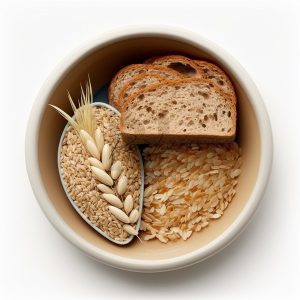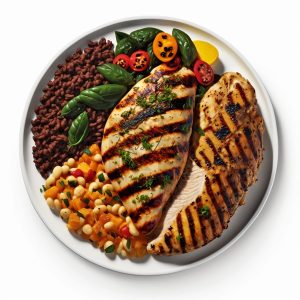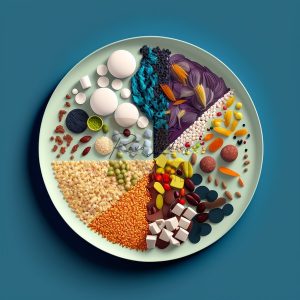Nutrition plays a vital role in maintaining a healthy lifestyle and preventing chronic diseases. In this article, we will provide expert information on how to incorporate various types of foods into your diet for optimal health and well-being. From whole grains to lean proteins, healthy fats, and special diets, this guide will help you make informed choices about what you eat and how to nourish your body.
Whole Grains

Whole grains, such as quinoa, brown rice, and whole wheat bread, are an excellent source of fiber, vitamins, and minerals. They are also less likely to spike blood sugar levels than refined grains and can help you feel full longer. It is recommended to choose whole grains over refined grains whenever possible. To incorporate whole grains into your diet, try swapping out white pasta for whole wheat pasta, or white rice for brown rice. Experiment with different types of whole grains, such as bulgur or barley, and consider incorporating them into salads, soups, and stews.
Unleash the Power of Whole Grains: Boost Your Health and Satisfy Your Hunger
Incorporating Lean Proteins

Lean proteins, such as chicken, fish, and legumes, are essential for repairing and building body tissues. They also help keep you feeling full and satisfied. It is recommended to choose lean proteins over high-fat meats, such as bacon or sausage. To incorporate lean proteins into your diet, try grilling or baking chicken or fish, and experiment with different types of legumes, such as lentils or chickpeas. Consider adding legumes to salads or soups, or using them as a base for veggie burgers. You can also try incorporating lean protein sources like tofu or tempeh into your meals.
Incorporating Healthy Fats

Healthy fats, such as those found in nuts, seeds, and fish, are essential for maintaining a healthy diet. They help absorb essential vitamins and minerals and can also help lower cholesterol levels and reduce the risk of heart disease. It is recommended to choose healthy fats over saturated fats found in animal products. To incorporate healthy fats into your diet, try snacking on nuts or seeds, such as almonds or pumpkin seeds, or adding them to your breakfast oatmeal or yogurt. You can also try adding avocado or olive oil to your meals for an extra boost of healthy fats. Fish, such as salmon or tuna, are also great sources of healthy fats and can be incorporated into your diet through grilling, baking, or even sushi.
Incorporating Special Diets
While a balanced diet is essential for maintaining a healthy lifestyle, some people may require special diets due to food allergies, intolerances, or medical conditions.
Vegetarian and Vegan Diets

Vegetarian and vegan diets are becoming increasingly popular. These diets exclude meat and animal products and can provide a wide variety of health benefits, such as a lower risk of heart disease and cancer. It is essential to ensure that you are getting all the necessary nutrients, such as protein and iron, by consuming a variety of plant-based foods. To incorporate a vegetarian or vegan diet into your lifestyle, try experimenting with meatless options like vegetable stir-fry, lentil dal, or a black bean burger. You can also explore various plant-based protein sources like tofu, tempeh, and seitan.
Gluten-Free Diets
A gluten-free diet is necessary for people with celiac disease or gluten intolerance. Gluten is a protein found in wheat, barley, and rye and can cause damage to the small intestine in those with the condition. A gluten-free diet requires avoiding foods that contain gluten and can provide a wide variety of health benefits, such as improved digestion and a lower risk of nutrient deficiencies. To incorporate a gluten-free diet, try experimenting with alternative grains such as quinoa, brown rice, or buckwheat. You can also try gluten-free breads, pasta, and crackers.
It’s important to note that a gluten-free diet should not be followed without medical guidance if you don’t have celiac disease or gluten intolerance as it can lead to deficiencies in important nutrients such as fiber and B vitamins. Additionally, it’s important to read food labels and ingredient lists carefully to ensure that gluten-free products do not contain other harmful ingredients.
Incorporating Seed Cycling
Seed cycling is a natural approach to support hormone balance. It involves incorporating specific seeds into your diet at specific times during your menstrual cycle. It is found that different seeds contain different amounts of lignans, phytoestrogens, and essential fatty acids that support hormone balance. Pumpkin seeds, for instance, contain high levels of zinc, a mineral that supports the production of progesterone, while sesame seeds contain lignans, which help to balance estrogen levels. To incorporate seed cycling into your diet, try adding pumpkin seeds to your breakfast during the first half of your menstrual cycle and switching to sesame seeds during the second half. You can also try adding flaxseeds or sunflower seeds to your diet to support hormone balance.
Eating healthy is essential for maintaining a healthy lifestyle and preventing chronic diseases. By understanding the basics of nutrition, the importance of portion control, and incorporating a balanced diet, you can make informed choices about what you eat. Additionally, by incorporating special diets and seed cycling, you can support your overall health and well-being. Remember, healthy eating is not about restriction, but about nourishing your body with the foods it needs to thrive.
Frequently Asked Questions
Q: What are the benefits of consuming whole grains?
A: Whole grains are an excellent source of fiber, vitamins, and minerals. They are also less likely to spike blood sugar levels than refined grains and can help you feel full longer.
Q: What are the best ways to incorporate whole grains into my diet?
A: To incorporate whole grains into your diet, try swapping out refined grains for whole grains in your meals. For example, choose whole wheat bread instead of white bread, quinoa instead of white rice, and brown rice instead of white rice. You can also try incorporating whole grains into your breakfast by choosing oatmeal or whole wheat cereal.
Q: What are the benefits of consuming lean proteins?
A: Lean proteins, such as chicken, fish, and legumes, are essential for repairing and building body tissues. They also help keep you feeling full and satisfied.
Q: What are the best ways to incorporate lean proteins into my diet?
A: To incorporate lean proteins into your diet, try grilling or baking chicken or fish, and experiment with different types of legumes, such as lentils or chickpeas. Consider adding legumes to soups, salads, or as a side dish.
Q: What are the benefits of consuming healthy fats?
A: Healthy fats, such as those found in nuts, seeds, and fish, are essential for maintaining a healthy diet. They help absorb essential vitamins and minerals and can also help lower cholesterol levels and reduce the risk of heart disease.
Q: What are the best ways to incorporate healthy fats into my diet?
A: Some ways to incorporate healthy fats into your diet include adding a handful of nuts or seeds to your meals, cooking with olive oil or avocado oil, and incorporating fatty fish such as salmon or tuna into your diet. You can also try incorporating flaxseeds or chia seeds into your smoothies or yogurt for an added boost of healthy fats.
Q: Is it necessary for me to follow a special diet?
A: Special diets, such as vegetarian and gluten-free, may be necessary for some individuals due to food allergies, intolerances, or medical conditions. It is important to consult with a healthcare professional to determine if a special diet is necessary for you.
Q: How can I ensure I am getting all the necessary nutrients while following a special diet?
A: It is important to do research and consult with a healthcare professional or a registered dietitian to ensure you are getting all the necessary nutrients while following a special diet. This may include adding supplements or finding alternative sources of specific nutrients.
Q: Can seed cycling really help balance my hormones?
A: While there is limited scientific research on the effects of seed cycling, some studies have found that consuming specific seeds at certain times of the menstrual cycle may have a positive effect on hormone balance. However, it is important to consult with a healthcare professional or a registered dietitian before starting any new diet or supplement routine.
Q: What are some of the best whole grains to include in my diet?
A: Some of the best whole grains to include in your diet are quinoa, brown rice, whole wheat bread, oats, barley, and bulgur. These grains provide a good source of fiber, vitamins, and minerals, and are less likely to spike blood sugar levels than refined grains.
Q: How can I make sure I’m getting all the necessary nutrients while following a special diet like gluten-free or vegetarian?
A: It’s important to do research and consult with a healthcare professional to ensure you are getting all the necessary nutrients while following a special diet. For gluten-free diets, alternative grains such as quinoa, brown rice, and buckwheat can provide important nutrients such as fiber and B vitamins. For vegetarian and vegan diets, it’s important to include a variety of plant-based foods such as legumes, nuts, and seeds to ensure adequate protein and iron intake.
Q: What are the benefits of seed cycling?
A: Seed cycling is a natural approach to support hormone balance by incorporating specific seeds into your diet at specific times during your menstrual cycle. Different seeds contain different amounts of lignans, phytoestrogens and essential fatty acids that support hormone balance. For example, pumpkin seeds contain high levels of zinc, a mineral that supports the production of progesterone, while sesame seeds contain lignans, which help to balance estrogen levels.


